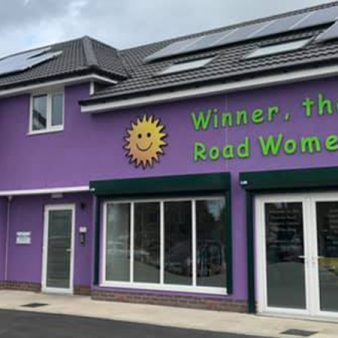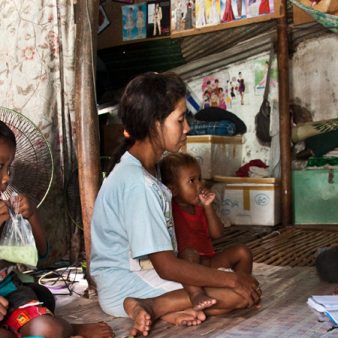The Build Together Programme of Namibia aims to meet large-scale housing needs through an enabling approach to housing provision. It was established in 1992 and by 1995 had reached 3,322 low-income and low/middle-income families who do not have access to formal housing credit. The Programme is a bold attempt by the government to show how the policy of enabling and facilitating can be put into practice. It is seen as a movement of the people, actively supported by the government and although still in its infancy, is providing houses at a much lower cost than could be achieved by the government alone.
The Republic of Namibia formally gained its independence in March 1990 after many years of domination by a variety of outside powers. The nation is one of many disparities. The GDP per capita of US$1,188 would seem to portray Namibia as a well-off middle-income country but 70 per cent of the nation’s wealth is accounted for by the six per cent of the population who are white. Disparities in housing are particularly pronounced because settlement planning and housing were used as tools of apartheid enforcement by the previous administration of the country. All the towns in Namibia are characterised by dual settlements with a well-serviced modern part for the minority and a poorly serviced part with ‘match-box’ type houses and shacks for the majority. Another legacy of apartheid are the overcrowded areas of former single-quarters, the hostel-type barracks which formerly housed male workers recruited from the countryside.
Not surprisingly, shelter and human settlements were identified as one of the four main development priorities of the new government of the country, alongside agriculture, health and education. A National Housing Policy was ratified by the government in July 1991. The Build Together Programme is part of this policy and is a bold attempt by the government to show how the policy of enabling and facilitating can be put into practice. By promoting housing by the people, the potential resources of the people, their skills, their ingenuity can be mobilised to supplement what the state can provide. The Programme seeks to involve all sectors in the housing process – government, families, communities, non-governmental organisations, community-based organisations and the private sector. It is seen as a movement of the people, actively supported by the government and has successfully shown that people can build better and cheaper houses than the authorities and that they are proud of their achievements.
The Build Together Programme has been in operation since 1992. During its three years of implementation it has reached 3,322 families in 60 sites spread throughout the 13 regions of the country. These 3,322 beneficiaries have all been granted loans to carry out approved works. Not all the dwellings are finished yet, some are still in progress and some still to commence. It is expected to cover ten sub-programmes covering the range of housing problems by the year 2000.
The programme aims to enable 70 per cent of the households of Namibia to have access to adequate shelter by the year 2000. This is to be achieved by the provision of affordable loans to meet a range of needs. These needs include providing services to a house which does not have them, the purchase of a serviced plot, the purchase of a plot together with a loan to build a house, the provision of roof sheets, upgrading of existing dwellings, a housing loan for savings groups or the community purchase of a partly serviced site. The costs of the various options are set out clearly for beneficiaries to understand. An excellent manual has also been prepared on the self-build process that describes in detail the construction process. Designs for a range of house-types are also included. All dwellings are capable of extension, as and when needs and resources permit.
Although the Build Together Programme has been successful in meeting housing needs of the lowest income groups as a level affordable by the beneficiaries and the Government, it cannot depend on government funding in the long-term if it is to be a sustainable programme. It is thus planned to establish a revolving fund in each of the 13 regions of the country to be capitalised from the capital development allocation. Assuming that the projected levels of funding are maintained for nine years and the current recovery rates of 80 per cent are maintained, these regional funds could be revolving and self-sustaining.
There has been a very high degree of participation of women in the Programme with over 45 per cent of the beneficiaries being women-headed households. These women are economic producers as well as mothers. They are creators of their shelter and protectors of their families, but in the past have experienced many problems relating to their rights to land and shelter. The Programme intends to encourage more women to take part, learning building skills and being a key part of the process. They will also be encouraged to form savings and credit societies to meet their regular credit needs as well as for improvement of their houses.
A key feature of the Programme is the establishment of Community Housing Development Groups (CHDG) in each local area. The role of these groups is to identify communities and families in need of housing or housing improvement in their area. They should also consult with them on how the community wants to solve their problems, prepare an implementation programme and submit it for funding. The CHDG also checks the credibility of loan applicants and monitors their building as well as playing a key role in checking the repayments of the borrowers. Local community leaders, local government officials and representatives of the beneficiaries are elected to these committees.
The beneficiaries can guarantee the loan in a variety of ways including a personal guarantee or one backed by the community, employer or government. The most effective way of ensuring good repayment is through community pressure and one of the tasks of the CDHGs is to ensure that repayments are made on time.
The government will only facilitate those aspects of housing that are beyond individual control. These include the provision of land with secure tenure, access to housing finance. The revision of existing building and construction standards, promotion of the development of local building materials and building components with the removal of legal, Institutional and procedural constraints to the alternative policies being introduced. It is also intended to improve the supply of information on the national housing situation and strengthen the performance capacity of institutions servicing the housing sector.
The Build Together Programme will in the future provide several types of support programme to help all those involved. These include a technical assistance service to help communities plan their settlements and design their houses, and to help local authorities block out plots and organise community installation of infrastructure. In addition they provide information on the use of local building materials and technologies. Community Resource Centres are to be established where this information and advice can be sought. Training in construction methods is also to be organised.
Although still in its infancy the Programme represents one of the most comprehensive attempts by any nation to implement the United Nations Global Shelter Strategy of enabling and facilitating people to build and improve their own homes.
Partnership
National government, local government, local community


